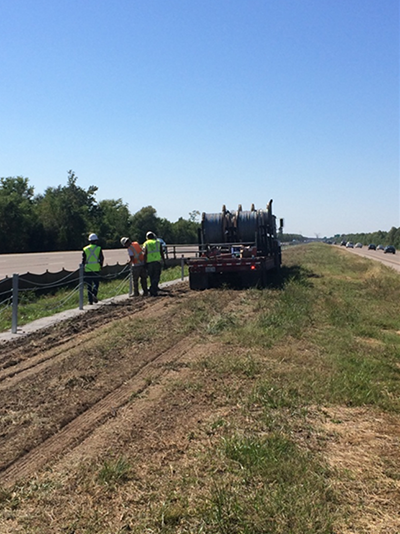Reducing Median Crossover Crashes through the Systemic Installation of Cable Median Barrier in Louisiana
Roadway Departure | March 2022

Figure 1. Installing cable median barrier
Source: Louisiana DOTD
CHALLENGE
Median crossover crashes often result in fatalities or severe injuries to occupants of the errant vehicle and the motorists in the opposing traffic lanes. Concrete and metal beam barriers traditionally used to prevent these types of crashes are expensive and difficult to install on sloped terrain where their performance is often suboptimal. Cable median barriers are an innovative and cost-effective solution to prevent head-on collisions, which often result in fatalities or serious injuries. They help to prevent collisions by deflecting vehicles that veer into the median and by stopping them from crossing over into oncoming traffic. In 2006, a legislative session helped to establish the need for a cable median barrier system in Louisiana by passing a resolution to explore the feasibility of installing this safety feature.
ACTION
The feasibility study included the installation of two pilot projects based on available data and best practices. In 2008, the first area to receive cable median barriers was along the entire length of I-10 in St. James Parish (6.8 miles) at a cost of $1.3 million. A second pilot project was completed in 2009 along the entire length of I-12 in St. Tammany Parish (32 miles) at a cost of $5.3 million. A Louisiana Department of Transportation & Development (LA DOTD) study of the pilot projects, conducted in 2010, recommended expanding the cable barrier system along I-10 and I-12 into 3 more parishes. In 2012, 18 projects were initiated for installation along interstates in 18 parishes based on average cross over crashes per mile. In 2015, a statewide systemic study was conducted to evaluate the completed projects. Based on the results of the study, LA DOTD developed a cable median barrier program on rural, high speed, fully controlled access facilities with project selection based on the width of the median (greater than 10’ and less than 100’) rather than number of historical cross over cashes per mile.
RESULT
As of February 2022, DOTD has installed approximately 620 miles of cable median barriers throughout the state at an investment of approximately $93 million. There are another 100 miles of cable median barrier under construction with a goal of installing cable median barriers along Louisiana’s rural interstate system by the end of 2023. Based on data from 2009 to 2013 following installation of the first round of projects, there has been a 33% reduction in cross median crashes. In terms of severity, cable median barriers have reduced fatal and serious injury crashes by almost 30% and 20%, respectively. A subsequent study is currently underway. Overall, Louisiana residents see the cable barriers as a positive safety feature to reduce potential for cross over crashes.
